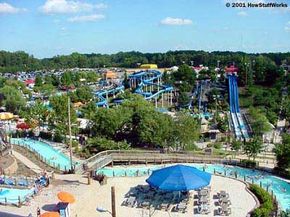In the amusement park industry, the roller coaster is king. But during the hot summer months, these classic attractions get some tough competition from waterslides. In the past 50 years, the world of waterslides has exploded. They've transformed from simple poolside slopes to intricate attractions that dominate entire amusement parks. According to the World Waterpark Association, there are more than 1,000 water parks in North America.
Water parks boast slides with dozens of loops, incredible speeds and exhilarating drops.The tallest free-fall waterslide on record is the 164-foot (50-meter) “Kilimanjaro” in the Aldeia das Aguas Park Resort in Brazil. If you’d rather ride down on a raft, you can take a plunge on the “Captain Spacemaker” at Aqualandia in Italy. The four-person raft can go up to 62 miles per hour. Whether you're on a mat, a raft or your bare skin, you're at the mercy of gravity as you make your way down — and sometimes up — the slippery slope.
Advertisement
A waterslide is like a wet roller coaster with no seat and no safety harness, and it works using the same principles as a roller coaster. In this article, we'll peek behind the scenes to find out what's involved in operating a waterslide, from pumping the water to cleaning it after the ride. We'll also see how the pieces of a water slide fit together and find out what keeps you from flying off into the air as you whip around corners.
